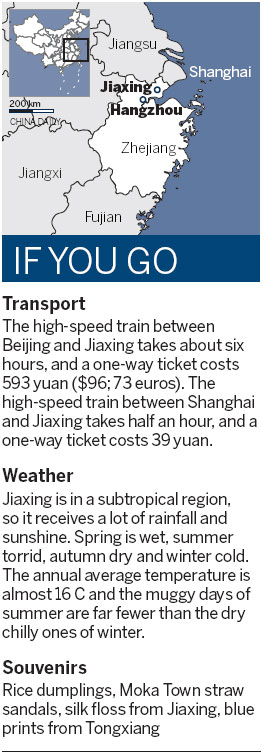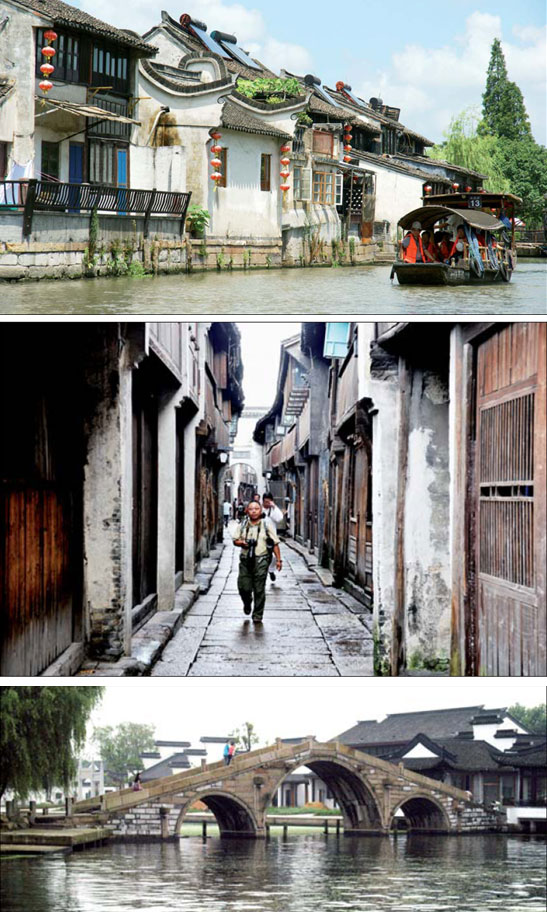A break from the city
Updated: 2012-11-02 07:49
(China Daily)
|
||||||||
|
From top: Well preserved architecture from the Ming and Qing dynasties (1368-1911) in Xitang; a narrow alley in Wuzhen, one of the six ancient towns south of the Yangtze River; and a stone arch bridge over Nanhu Lake. Photos provided to China Daily |
With its web of tranquil lanes and waterways, Jiaxing takes visitors back in time
News reports about East China are normally about the region's strong manufacturing base and international business links, or because it has driven the country's economic development for three decades.
Beauty and serenity are words rarely used to describe the region, but just 100 kilometers from Shanghai, one of China's busiest cities, sits the tranquility of Jiaxing water town, a prefecture-level city in northern Zhejiang province.
Located in the central part of the Yangtze Delta, Jiaxing is well placed for travelers. It takes about 30 minutes to reach Shanghai by high-speed train and the city sits on the route between the picturesque towns of Suzhou and Hangzhou.
Every August the city hosts the international Qiantang River Tidal Bore Festival, which features Chinese folk customs and singing and dancing. For businesspeople whose days are filled with meetings in the skyscrapers of Shanghai, Jiaxing makes for a refreshing break. There are many areas to visit Jiaxing:
1. Nanhu Lake
Located in the southeast of Jiaxing with beautiful scenery and history stretching back more than 2,000 years, Nanhu Lake is among the four largest in Zhejiang province, along with Xihu Lake in Hangzhou, Donghu Lake in Shao xing and Dongqian Lake in Ningbo.
Every May tourism festivals are held along the banks of Nanhu Lake, where visitors are invited to place lotus lamps into the water and enjoy boating shows.
Local people greet visitors with rice dumplings and prepare traditional Chinese prints for exhibition.
2. Wuzhen Town

Wuzhen is one of six ancient towns south of the Yangtze River with a history of more than 1,000 years. It is one of the most famous towns in the region and features elegant black tiled oil-painted timber framework houses that contrast sharply with white walls and gray flagging, along both sides of the riverbank.
The city is divided into six areas for traditional workshops, local-style houses, culture, food and drink, traditional shops and a water township customs and life district.
Visitors can wander the atmospheric streets, listen to storytellers, or just jump in a small boat for a different kind of ride through town.
3. Xitang
Xitang is an ancient town famous for its many covered corridors, lanes and bridges. Nine rivers converge in the town, dividing it into eight sectors. They are crossed by numerous bridges linking the different areas together.
Inside Xitang there is well preserved architecture from the Ming and Qing dynasties (1368-1911), which boasts a high level of artistry. The area is a popular for study among academics from China and abroad.
Strolling along the town's covered corridors, watching boats pass by on the river, draws visitors into the place's history.
The town is crisscrossed by lanes and passages, the narrowest of which is just 80 centimeters wide and passable by just one person at a time.
Like rope, these byways hold the town together in a kind of organic net by which all roads interconnect and eventually lead back to one another.
The bridges on the lower reaches of the Yangtze River are like a hyperlink to the Internet. They are indispensable not only in terms of convenience but also in terms of beauty. Waterways are interwoven in Xitang and crossed by an abundance of bridges, each unique.
Eating and drinking
The region's specialties include sister-in-law biscuit, Wuzhen mutton, three-white liquor, Sanzhen zhai marinated duck, and water chestnuts.
China Daily
(China Daily 11/02/2012 page22)

 Relief reaches isolated village
Relief reaches isolated village
 Rainfall poses new threats to quake-hit region
Rainfall poses new threats to quake-hit region
 Funerals begin for Boston bombing victims
Funerals begin for Boston bombing victims
 Quake takeaway from China's Air Force
Quake takeaway from China's Air Force
 Obama celebrates young inventors at science fair
Obama celebrates young inventors at science fair
 Earth Day marked around the world
Earth Day marked around the world
 Volunteer team helping students find sense of normalcy
Volunteer team helping students find sense of normalcy
 Ethnic groups quick to join rescue efforts
Ethnic groups quick to join rescue efforts
Most Viewed
Editor's Picks

|

|

|

|

|

|
Today's Top News
Chinese fleet drives out Japan's boats from Diaoyu
Health new priority for quake zone
Inspired by Guan, more Chinese pick up golf
Russia criticizes US reports on human rights
China, ROK criticize visits to shrine
Sino-US shared interests emphasized
China 'aims to share its dream with world'
Chinese president appoints 5 new ambassadors
US Weekly

|

|








